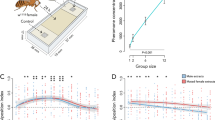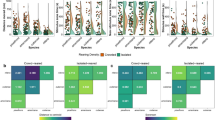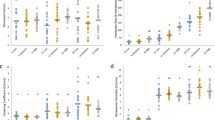Abstract
PLANARIA are known to form large aggregations in the laboratory and in the wild1. One of us (J. H. R.) has shown2 that planaria aggregate in conditions of homogeneous illumination, in the dark and when two species are maintained together, differentially according to species. Furthermore, the effect is general, being found in several species of planaria3. These results support a pheromone or chemotaxis interpretation of aggregation formation in which planaria presumably secrete chemical substances to which planaria are positively chemotactic.
This is a preview of subscription content, access via your institution
Access options
Subscribe to this journal
Receive 51 print issues and online access
$199.00 per year
only $3.90 per issue
Buy this article
- Purchase on Springer Link
- Instant access to full article PDF
Prices may be subject to local taxes which are calculated during checkout
Similar content being viewed by others
References
Pearl, R., Quart. J. Microsc. Sci., 46, 509 (1903). Walter, H. E., J. Exp. Zool., 5, 35 (1907). Allee, W. C., Animal Aggregations (University of Chicago Press, 1931).
Reynierse, J. H., Animal Behav., 14, 246 (1966); 15, 270 (1967).
Reynierse, J. H., and Ellis, R. R., Nature, 214, 895 (1967).
Fraenkel, G. S., and Gunn, D. L., The Orientation of Animals (Dover Publications, 1961).
Siegel, S., Nonparametric Statistics for the Behavioral Sciences (McGraw-Hill, 1956).
Tinbergen, N., Social Behaviour in Animals (Methuen, 1953).
von Frisch, K., The Dance Language and Orientation of Bees (Harvard University Press, 1967). Lindauer, M., Communication Among Social Bees (Atheneum, 1967).
Jacobson, A. L., Psychol. Bull., 60, 74 (1963). Best, J. B., in Learning and Associated Phenomena in Invertebrates (edit. by Thorpe, W. H., and Davenport, D.) (Baillière, Tindall and Cassell, 1964).
Jensen, D. D., in Learning and Associated Phenomena in Invertebrates (edit. by Thorpe, W. H., and Davenport, D.) (Baillière, Tindall and Cassell, 1964).
Author information
Authors and Affiliations
Rights and permissions
About this article
Cite this article
REYNIERSE, J., SCAVIO, M. Contrasting Background Conditions for Aggregation in Planaria. Nature 220, 258–260 (1968). https://doi.org/10.1038/220258a0
Received:
Revised:
Issue Date:
DOI: https://doi.org/10.1038/220258a0
Comments
By submitting a comment you agree to abide by our Terms and Community Guidelines. If you find something abusive or that does not comply with our terms or guidelines please flag it as inappropriate.



